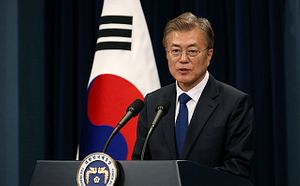South Korean President Moon Jae-in will meet U.S. President Donald J. Trump next week in Washington. The meeting will mark the first between the two leaders since Moon took office after an early election in May. At the top of the agenda when Moon arrives in Washington will be the common threat both countries face from North Korea. The Trump administration has made North Korea its top security priority going back to the presidential transition, pursuing a policy of “maximum pressure” that’s really more an iteration on the Obama administration’s policy of “strategic patience.” Meanwhile, Moon, a liberal, has indicated that he would prefer to calm inter-Korean tensions by offering incentives to Pyongyang to cease its ballistic missile and nuclear testing.
Ahead of next week’s summit, Moon gave an interview to the Washington Post that is well worth reading to get a sense of where the new Korean administration sits on a range of issues, ranging from the alliance, to North Korea, and even the controversial Terminal High Altitude Area Defense (THAAD) system deployment in South Korea.
First, Moon makes it clear that he’d like for inter-Korean relations to progress in “close consultation” with the United States, but adds that the process should effectively be Korea-led. “Korea should now play a larger and more leading role in this process,” he notes. “During the periods when South Korea played a more active role, the inter-Korean relationship was more peaceful and there was less tension between the United States and North Korea,” Moon adds, hearkening perhaps back to the early 2000s, when his liberal predecessors, Kim Dae-jung and Roh Moo-hyun, pursued inter-Korean rapprochement via the Sunshine Policy.
Moon’s remarks here aren’t entirely unsurprising. Moon Chung-in, Moon’s special adviser on unification, foreign affairs, and national security, generated a stir with remarks at a think tank in Washington, D.C., this week with a more detailed proposal. He suggested that the United States should enter discussions on reducing the scope of U.S.-South Korea military exercises in exchange for a suspension of North Korean testing.
This isn’t a new idea; North Korea has long treated the annual Key Resolve/Foal Eagle exercises as an intimidating show of force for a preemptive strike. Even China has supported a tit-for-tat exchange along these lines. Still, it’s notable that Moon’s advisers are thinking along these lines. Moon Chung-in added that South Korea could perhaps even explore a reduction in the presence of U.S. strategic assets — presumably bombers — that are deployed to the peninsula too.
Second, speaking to the Washington Post, Moon addresses the question of possible incentives that could be offered to North Korea, including the potential resumption of operations at the Kaesong Industrial Complex — a joint inter-Korean special economic zone that was suspended following North Korea’s nuclear test last January. Moon readily concedes that reopening Kaesong — or even other concessions like offering the North Koreans cash — would violate existing United Nations and U.S. sanctions.
Effectively, Moon is aware that the stage is far from set for “Sunshine 2.0” given international constraints and even South Korean domestic legal constraints. But, he notes, “what Korea and the U.S. both ultimately seek to achieve is the dismantlement of North Korea’s nuclear program” and he seems willing to try a combination of both carrots and sticks to achieve that objective. (The “stick” being the continued enforcement of “pressure.”)
Third, Moon addresses the issue of the THAAD battery in South Korea head-on. Recently, his government decided to suspend the deployment of four additional launchers after it emerged that the South Korean military had concealed their arrival from his office. The Moon government holds that it will conduct an environmental impact assessment before moving forward with the final deployment of these launchers; in the meantime, the AN/TPY-2 X-band radar system associated with the battery and two launchers maintain the same operational capability they’ve had since early May.
When asked point blank by the Post‘s Lally Weymouth if his government would proceed with the full deployment of all the THAAD launchers, Moon replied, “It is not that simple,” adding that “we must go through due process, which involves an environmental impact assessment.” The THAAD issue may emerge as a sharp point of contention between Moon and Trump when they meet next week.
Recall that in the days leading up to the South Korean election, Trump floated the idea that Seoul should foot a “$1 billion” bill for the deployment — never mind that THAAD is in South Korea primarily to protect U.S. assets from a North Korean ballistic missile attack. Aside from Trump’s position, Moon himself had been a sharp critic of THAAD while the conservative government of his now-disgraced predecessor Park Geun-hye pushed for its deployment. He softened his stance on the system once it became clear that an election would take place sooner than December 2017 — the originally scheduled date before Park’s impeachment and removal from office.
These issues and more will come to a head next week with the Trump-Moon meeting, which could emerge as one of the most consequential South Korea-U.S. summits in some time. Moon and Trump — despite the former’s exhortations that they see eye-to-eye on North Korea — have fundamental disagreements on both style and substance. Next week’s meeting will be determinative of whether the alliance can successfully coordinate on North Korea as the threat from Pyongyang shows no signs of abating. But even beyond North Korea, it will be incumbent on Moon and Trump to make sure that the broader U.S.-South Korea alliance and all it encompasses, including the U.S.-South Korea Free Trade Agreement, remains in good health.

































